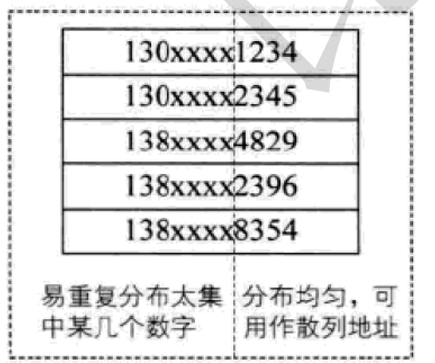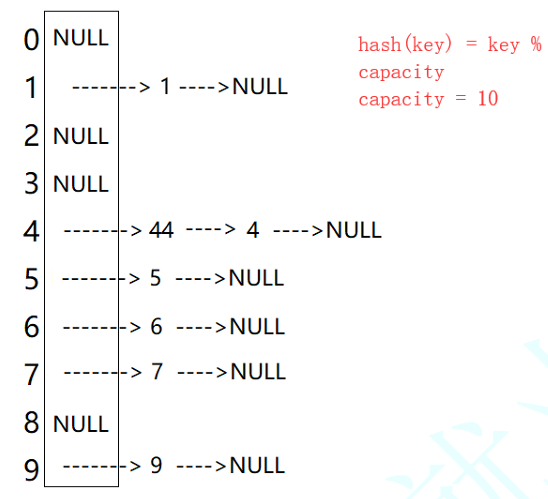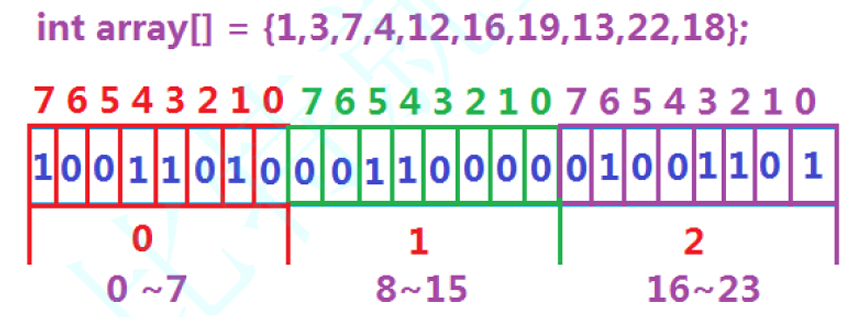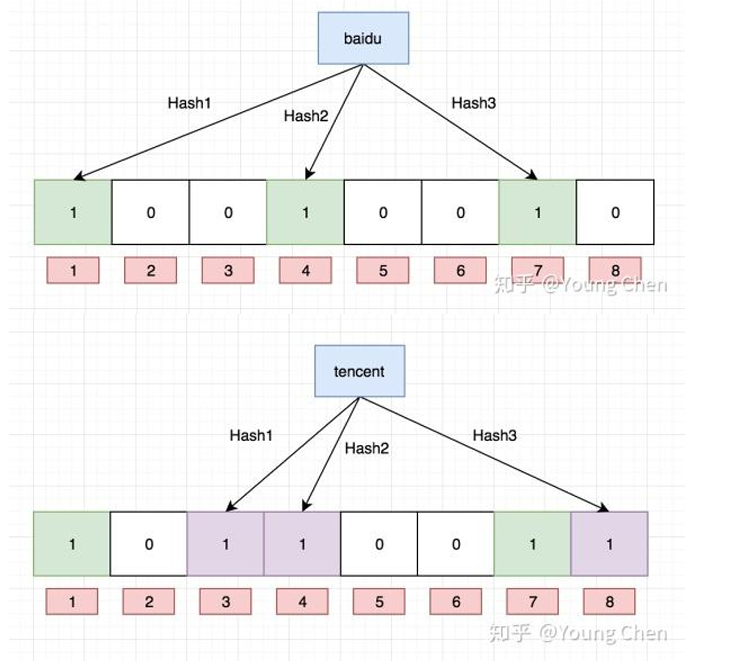文章目录
unordered系列关联性容器
STL提供了底层为红黑树的一系列容器,查询的效率为log2n,即最差情况下需查询红黑树高度次,如果数据太多,查询效率还是不理想,所以c++11又提供了unordered系列容器查询效率可达O(1),使用方法与红黑树系列容器基本一致,只是底层不一样,也有4个
unordered_map, unordered_set, unordered_multimap, unordered_multiset
unordered_map
unordered_map文档
特性:
1,unordered_map存储<key,value>键值对,通过key值直接找到value
2,unordered_map存储key值唯一,value是映射值,两者类型可以不同。
3,unordered_map没有对<key,value>进行任何排序
4,unordered_map将相同哈希值存到同一个哈希桶中
5,unordered_map查询比map快,但遍历元素比map慢,(因为要遍历许多空的哈希桶)
6,unordered_map实现了[],可以直接通过key访问value
接口:
1 构造:
| unordered_map | 构造各种类型的unordered_map对象 |
2 容量:
| bool empty() const | 检查unordered_map是否为空 |
| size_t size() const | 检查unordered_map有效元素个数 |
3 迭代器:
| begin() | 返回第一个元素的迭代器 |
| end() | 返回最后一个元素下一个元素迭代器 |
| cbegin() | 返回第一个元素const迭代器 |
| cend() | 返回最后一个元素下一个元素const迭代器 |
4 💪元素访问[]
| operator[] | 通过key访问value |
❤注意,该函数实际调用插入操作,
⭐如果哈希表中无key,直接插入并返回 V(),
⭐如果哈希表有key插入失败,说明存在,返回value值,
5 查询
| iterator find(const K& key) | 返回key值在哈希桶中位置 |
| size_t count(const K& key) | 返回哈希桶中关键码为key的个数 |
注意:unordered_map中count最多为1
6 修改
| insert(make_pair()) | 插入键值对 |
| erase(const K& key) | 删除key值 |
| void clear() | 清空容器 |
| void swap(const unordered_map& ) | 交换两个容器元素 |
7 unordered_map桶操作
| size_t bucket_count() const | 返回哈希桶中桶的个数 |
| size_t bucket(const K&key) | 返回key值在哈希桶号 |
| size_t bucket_size(size_t n) | 返回n号哈希桶有效元素个数 |
#include <iostream>
#include <unordered_map>
using namespace std;
int main()
{
int a[] = { 5,8,7,6,89,5,3,5,5,4,11};
unordered_map<int, int> mp;
for (auto& e : a)
{
mp.insert(make_pair(e, e));
}
cout << mp.bucket_count()<<endl;
for (auto& e:a)
{
cout<<mp.bucket(e)<<" ";
}
return 0;
}

unordered_set没什么好说的,与set区别就是无顺序,
unordered_set文档
❤底层结构
哈希系列容器之所以效率高,因为使用了哈希结构
哈希概念
顺序结构和平衡树中关键码和对应位置无关系,因此查询一个元素时,必须经过关键码的多次比较,顺序结构O(N),树形结构O(logN),效率取决于比较次数
理想搜索方法,=不经过任何比较一次性直接找到值,将关键码和存储位置建立一一映射关系,搜索时直接找到。
向该结构中
- ⭐插入元素:将关键值交给哈希函数 ,计算出存储位置的值并在该位置存储
- ⭐搜索元素:将关键值交给哈希函数,将计算出的值当作存储位置,若此位置关键码相等,则搜索成功,
例如集合{1,7,6,4,5,9}
将哈希函数设置为 hash(key)= key%capacity,capacity为底层存储空间总大小

🚩此方法即为哈希方法,用此方法使用的转换函数叫作哈希函数,构造出来的结构为哈希表或散列表
用该方法不需要多次比较,可以直接搜索到元素,因此效率快
问题,如果插入44会怎样?
44%10=4,但位置已有4了,出现哈希冲突
哈希冲突
不同关键字通过哈希函数计算出相同哈希地址,这种叫做哈希冲突或哈希碰撞
把具有不同关键字具有相同哈希地址的数据元素叫同义词
哈希函数
引发哈希冲突的一个原因是哈希函数设置不够合理,
哈希函数设计原则:
- 哈希函数定义域必须囊括所有存储数据的地址,如果散列表有m个地址,那么数据地址个数0到m-1
- 哈希函数计算出的地址要能平均分配在散列表
- 哈希函数要比较简单
常见哈希函数
1 🚩直接定址法
取关键字的某个线性函数为散列地址:hash(key) =A*key+B
优点:简单 均匀
缺点:需要事先知道关键字分布情况=
比较适合数据量小且连续情况
2 🚩除留取余法
散列表最多存储m个地址,那么取一个不大于m,但最接近m或等于m的质数p作除数,哈希函数: hash(key)=key%p,将关键码转为地址
- 平方取中法–(了解)
假设关键字为1234,对它平方就是1522756,抽取中间的3位227作为哈希地址;
再比如关键字为4321,对它平方就是18671041,抽取中间的3位671(或710)作为哈希地址
平方取中法比较适合:不知道关键字的分布,而位数又不是很大的情况 - 折叠法–(了解)
折叠法是将关键字从左到右分割成位数相等的几部分(最后一部分位数可以短些),然后将这
几部分叠加求和,并按散列表表长,取后几位作为散列地址。
折叠法适合事先不需要知道关键字的分布,适合关键字位数比较多的情况 - 随机数法–(了解)
选择一个随机函数,取关键字的随机函数值为它的哈希地址,即H(key) = random(key),其中
random为随机数函数。
通常应用于关键字长度不等时采用此法 - 数学分析法–(了解)
设有n个d位数,每一位可能有r种不同的符号,这r种不同的符号在各位上出现的频率不一定
相同,可能在某些位上分布比较均匀,每种符号出现的机会均等,在某些位上分布不均匀只
有某几种符号经常出现。可根据散列表的大小,选择其中各种符号分布均匀的若干位作为散
列地址。

某公司员工登记表,前7位容易相同,所以取后4位作散列地址,
数字分析法适合关键码位数多的情况,需要事先知道关键码分布且关键码若干位数分布较均匀情况,
注意:合适的哈希函数可以降低冲突,但是无法避免哈希冲突
解决哈希冲突
两种方法闭散列和开散列
闭散列
也叫开放地址法,哈希表只要没全满,就可以把冲突的数据放在空桶上
那么如何找到空桶?
1, 线性探测:
== 从冲突的位置开始向后寻找,找到空桶就放入==
如上面 44数据

放到了8位置
删除:
不能直接删除,如果删除4位置,再寻找44时,先找到4位置,发现是空的,返回错误,
但实际44在8位置存放,所以删除时要伪标记
❤// 哈希表每个空间给个标记
// EMPTY此位置空, EXIST此位置已经有元素, DELETE元素已经删除
enum State{EMPTY, EXIST, DELETE};
enum STATE
{
EMPTY,
EXIST,
DELETE
};
template<class K, class V>
struct HashNode
{
pair<K, V> _kv;
STATE _state = EMPTY;
};
template<class K>
struct DefaultHashFunc
{
size_t operator()(const K& key)
{
return (size_t)key;
}
};
template<>
struct DefaultHashFunc<string>
{
size_t operator()(const string& str)
{
size_t hash = 0;
//BKDR
for (auto& ch : str)
{
hash *= 131;
hash += ch;
}
return hash;
}
};
namespace jib {
template<class K, class V, class HashFunc = DefaultHashFunc<K>>
class HashTable
{
public:
typedef HashNode<K, V> Node;
HashTable()
{
_table.resize(10);
}
bool Insert(const pair<K, V>& kv)
{
//扩容
if (_n * 10 / _table.size() > 7)
{
size_t newsize = _table.size() * 2;
HashTable<K, V, HashFunc> newHT;
newHT._table.resize(newsize);
for (size_t i = 0;i < _table.size();i++)
{
newHT.Insert(_table[i]._kv);
}
_table.swap(newHT._table);
}
HashFunc hf;
size_t hashi = hf(kv.first) % _table.size();
while (_table[hashi]._state == EXIST)
{
++hashi;
hashi %= _table.size();
}
_table[hashi]._kv = kv;
_table[hashi]._state = EXIST;
++_n;
return true;
}
HashNode<const K, V>* Find(const K& key)
{
HashFunc hf;
size_t hashi = hf(key) % _table.size();
while (_table[hashi]._state != EMPTY)
{
if (_table[hashi]._state == EXIST && _table[hashi]._kv.first == hf(key))
{
return (HashNode<const K, V>*) & _table[hashi];
}
++hashi;
hashi %= _table.size();
}
return nullptr;
}
bool Erase(const K& key)
{
HashNode<const K, V>* ret = Find(key);
if (ret)
{
ret.state = DELETE;//设状态
--_n;
return true;
}
return false;
}
private:
vector<HashNode<K, V>> _table;
size_t _n = 0;//有效个数
};
}
HashFunc是仿函数,作用取出key的关键码,如果key是int类型直接返回,如果string用BKDR算法返回关键码
思考:哈希表在什么情况下扩容?如何扩容?
答:负载因子>=0.7时
负载因子:元素的有效个数/哈希表长度,负载因子越大说明哈希表越满,越容易出现冲突,
当负载因子>=0.7时就扩容
线性探测优点:实现简单
线性探测缺点:发生哈希冲突时容易出现数据堆积,即不同关键码数据把一段哈希表占满了,再冲突需要多次比较才能找到空位置,效率低
所以有了二次探测
有了哈希函数计算出的地址,线性探测只能向后找,容易堆积,二次探测可以向左找一次向右找一次,或者向右跳两格,向右跳三格,左跳两格右跳两格。
闭散列最大缺陷就是空间利用率低,这也是哈希的缺陷
开散列
开散列法,又叫链地址法,通过哈希函数计算出地址后,具有相同关键码的数据放在同一个子集中,每一个子集称为一个桶,各个桶的元素通过单链表存储起来,每个链表的头节点存在散列表中

开散列实现:
namespace hash_bucket
{
template<class K, class V>
struct HashNode
{
pair<K, V> _kv;
HashNode<K, V>* _next;
HashNode(const pair<K, V>& kv)
:_kv(kv)
,_next(nullptr)
{}
};
template<class K, class V, class HashFunc = DefaultHashFunc<K>>
class HashTable
{
typedef HashNode<K, V> Node;
public:
HashTable()
{
_table.resize(10, nullptr);
}
~HashTable()
{
for (size_t i = 0; i < _table.size(); i++)
{
Node* cur = _table[i];
while (cur)
{
Node* next = cur->_next;
delete cur;
cur = next;
}
_table[i] = nullptr;
}
}
bool Insert(const pair<K, V>& kv)
{
if(Find(kv.first))
{
return false;
}
HashFunc hf;
// 负载因子到1就扩容
if (_n == _table.size())
{
size_t newSize = _table.size()*2;
vector<Node*> newTable;
newTable.resize(newSize, nullptr);
// 遍历旧表,顺手牵羊,把节点牵下来挂到新表
for (size_t i = 0; i < _table.size(); i++)
{
Node* cur = _table[i];
while (cur)
{
Node* next = cur->_next;
// 头插到新表
size_t hashi = hf(cur->_kv.first) % newSize;
cur->_next = newTable[hashi];
newTable[hashi] = cur;
cur = next;
}
_table[i] = nullptr;
}
_table.swap(newTable);
}
size_t hashi = hf(kv.first) % _table.size();
// 头插
Node* newnode = new Node(kv);
newnode->_next = _table[hashi];
_table[hashi] = newnode;
++_n;
return true;
}
Node* Find(const K& key)
{
HashFunc hf;
size_t hashi = hf(key) % _table.size();
Node* cur = _table[hashi];
while (cur)
{
if (cur->_kv.first == key)
{
return cur;
}
cur = cur->_next;
}
return nullptr;
}
bool Erase(const K& key)
{
HashFunc hf;
size_t hashi = hf(key) % _table.size();
Node* prev = nullptr;
Node* cur = _table[hashi];
while (cur)
{
if (cur->_kv.first == key)
{
if (prev == nullptr)
{
_table[hashi] = cur->_next;
}
else
{
prev->_next = cur->_next;
}
delete cur;
return true;
}
prev = cur;
cur = cur->_next;
}
return false;
}
void Print()
{
for (size_t i = 0; i < _table.size(); i++)
{
printf("[%d]->", i);
Node* cur = _table[i];
while (cur)
{
cout << cur->_kv.first <<":"<< cur->_kv.second<< "->";
cur = cur->_next;
}
printf("NULL\n");
}
cout << endl;
}
private:
vector<Node*> _table; // 指针数组
size_t _n = 0; // 存储了多少个有效数据
};
}
链地址法比闭散列节省空间,(闭散列需要开大量的空间来确保搜索效率)
❤改造哈希表
增加迭代器
// 前置声明
template<class K, class T, class KeyOfT, class HashFunc>
class HashTable;
template<class K, class T, class Ptr, class Ref, class KeyOfT, class HashFunc>
struct HTIterator
{
typedef HashNode<T> Node;
typedef HTIterator<K, T, Ptr, Ref, KeyOfT, HashFunc> Self;
typedef HTIterator<K, T, T*, T&, KeyOfT, HashFunc> Iterator;
Node* _node;
const HashTable<K, T, KeyOfT, HashFunc>* _pht;
HTIterator(Node* node, const HashTable<K, T, KeyOfT, HashFunc>* pht)
:_node(node)
, _pht(pht)
{}
// 普通迭代器时,他是拷贝构造
// const迭代器时,他是构造
HTIterator(const Iterator& it)
:_node(it._node)
, _pht(it._pht)
{}
Ref operator*()
{
return _node->_data;
}
Ptr operator->()
{
return &_node->_data;
}
Self& operator++()
{
if (_node->_next)
{
// 当前桶还没完
_node = _node->_next;
}
else
{
KeyOfT kot;
HashFunc hf;
size_t hashi = hf(kot(_node->_data)) % _pht->_table.size();
// 从下一个位置查找查找下一个不为空的桶
++hashi;
while (hashi < _pht->_table.size())
{
if (_pht->_table[hashi])
{
_node = _pht->_table[hashi];
return *this;
}
else
{
++hashi;
}
}
_node = nullptr;
}
return *this;
}
bool operator!=(const Self& s)
{
return _node != s._node;
}
bool operator==(const Self& s)
{
return _node == s._node;
}
};
template<class K, class T, class KeyOfT, class HashFunc = DefaultHashFunc<K>>
class HashTable
{
typedef HashNode<T> Node;
// 友元声明
template<class K, class T, class Ptr, class Ref, class KeyOfT, class HashFunc>
friend struct HTIterator;
public:
typedef HTIterator<K, T, T*, T&, KeyOfT, HashFunc> iterator;
typedef HTIterator<K, T, const T*, const T&, KeyOfT, HashFunc> const_iterator;
iterator begin()
{
// 找第一个桶
for (size_t i = 0; i < _table.size(); i++)
{
Node* cur = _table[i];
if (cur)
{
return iterator(cur, this);
}
}
return iterator(nullptr, this);
}
iterator end()
{
return iterator(nullptr, this);
}
const_iterator begin() const
{
// 找第一个桶
for (size_t i = 0; i < _table.size(); i++)
{
Node* cur = _table[i];
if (cur)
{
return const_iterator(cur, this);
}
}
return const_iterator(nullptr, this);
}
const_iterator end() const
{
return const_iterator(nullptr, this);
}
//除留余数法
size_t GetNextPrime(size_t prime)
{
static const int __stl_num_primes = 28;
static const unsigned long __stl_prime_list[__stl_num_primes] =
{
53, 97, 193, 389, 769,
1543, 3079, 6151, 12289, 24593,
49157, 98317, 196613, 393241, 786433,
1572869, 3145739, 6291469, 12582917, 25165843,
50331653, 100663319, 201326611, 402653189, 805306457,
1610612741, 3221225473, 4294967291
};
size_t i = 0;
for (; i < PRIMECOUNT; ++i)
{
if (primeList[i] > prime)
return primeList[i];
}
return primeList[i];
}
HashTable()
{
_table.resize(GetNextPrime(1), nullptr);
}
~HashTable()
{
for (size_t i = 0; i < _table.size(); i++)
{
Node* cur = _table[i];
while (cur)
{
Node* next = cur->_next;
delete cur;
cur = next;
}
_table[i] = nullptr;
}
}
pair<iterator, bool> Insert(const T& data)
{
KeyOfT kot;
iterator it = Find(kot(data));
if(it != end())
{
return make_pair(it, false);
}
HashFunc hf;
// 负载因子到1就扩容
if (_n == _table.size())
{
//size_t newSize = _table.size() * 2;
size_t newSize = GetNextPrime(_table.size());
vector<Node*> newTable;
newTable.resize(newSize, nullptr);
// 遍历旧表,顺手牵羊,把节点牵下来挂到新表
for (size_t i = 0; i < _table.size(); i++)
{
Node* cur = _table[i];
while (cur)
{
Node* next = cur->_next;
// 头插到新表
size_t hashi = hf(kot(cur->_data)) % newSize;
cur->_next = newTable[hashi];
newTable[hashi] = cur;
cur = next;
}
_table[i] = nullptr;
}
_table.swap(newTable);
}
size_t hashi = hf(kot(data)) % _table.size();
// 头插
Node* newnode = new Node(data);
newnode->_next = _table[hashi];
_table[hashi] = newnode;
++_n;
return make_pair(iterator(newnode, this), true);
}
iterator Find(const K& key)
{
HashFunc hf;
KeyOfT kot;
size_t hashi = hf(key) % _table.size();
Node* cur = _table[hashi];
while (cur)
{
if (kot(cur->_data) == key)
{
return iterator(cur, this);
}
cur = cur->_next;
}
return end();
}
bool Erase(const K& key)
{
HashFunc hf;
KeyOfT kot;
size_t hashi = hf(key) % _table.size();
Node* prev = nullptr;
Node* cur = _table[hashi];
while (cur)
{
if (kot(cur->_data) == key)
{
if (prev == nullptr)
{
_table[hashi] = cur->_next;
}
else
{
prev->_next = cur->_next;
}
--_n;
delete cur;
return true;
}
prev = cur;
cur = cur->_next;
}
return false;
}
void Print()
{
for (size_t i = 0; i < _table.size(); i++)
{
printf("[%d]->", i);
Node* cur = _table[i];
while (cur)
{
cout << cur->_kv.first <<":"<< cur->_kv.second<< "->";
cur = cur->_next;
}
printf("NULL\n");
}
cout << endl;
}
private:
vector<Node*> _table; // 指针数组
size_t _n = 0; // 存储了多少个有效数据
};
}
模拟实现set
namespace jib
{
template<class K>
class unorderedset
{
struct SetKeyOfT
{
const K& operator()(const K& key)
{
return key;
}
};
public:
typedef typename Hash_Bucket::Hash_Table<K ,K,SetKeyOfT>::const_iterator const_iterator;
typedef typename Hash_Bucket::Hash_Table<K, K, SetKeyOfT>::const_iterator iterator;
const_iterator begin() const
{
return _hb.begin();
}
const_iterator end() const
{
return _hb.end();
}
pair<const_iterator,bool> Insert(const K& key)
{
//return _hb.Insert(key);
pair<typename Hash_Bucket::Hash_Table<K, K, SetKeyOfT>::iterator, bool> ret = _hb.Insert(key);
return pair<const_iterator, bool>(ret.first, ret.second);
}
Hash_Bucket::Hash_Table<K, K, SetKeyOfT> _hb;
};
}
模拟实现map
namespace jib {
template<class K,class V>
class unorderedmap
{
struct MapKeyOfT
{
const K& operator()(const pair<K, V>& kv)
{
return kv.first;
}
};
public:
typedef typename Hash_Bucket::Hash_Table<K, pair<K, V>, MapKeyOfT>::iterator iterator;
typedef typename Hash_Bucket::Hash_Table<K, pair<K, V>, MapKeyOfT>::const_iterator const_iterator;
iterator begin()
{
return _hb.begin();
}
const_iterator begin() const
{
return _hb.begin();
}
iterator end()
{
return _hb.end();
}
const_iterator end() const
{
return _hb.end();
}
pair<iterator,bool> Insert(const pair<K,V>& kv)
{
return _hb.Insert(kv);
}
V& operator [](const K& key)
{
pair<iterator, bool> ret = _hb.Insert(make_pair((key), V()) );
return ret.first->second;
}
private:
Hash_Bucket::Hash_Table<K, pair<K, V>, MapKeyOfT> _hb;
};
}
❤ 哈希的应用
位图
面试题:给40亿个不重复的无符号整数,给出一个无符号整数,没排过序,如何快速判断是否在40亿个数当中。
❤位图:数据是否在整数中,在不在正好是两种状态,刚好用一个二进制bit位解决
一个整数32bit位,那就可以代表32个数是否存在
如:

用与位实现0,或位实现1
位图实现:
#include <iostream>
#include <vector>
using namespace std;
namespace jib {
template <size_t N>
class bitset
{
public:
bitset()
{
_a.resize(N / 32 + 1);
}
void set(size_t x)
{
//变1 或门
int i = x / 32;
int j = x % 32;
_a[i] |= (1 << j);
}
void reset(size_t x)
{
//变0 与门
int i = x / 32;
int j = x % 32;
_a[i] &= (~(1<<j));
}
bool test(size_t x)
{
int i = x / 32;
int j = x % 32;
//判断是否为1
return _a[i] & (1 << j);
}
private:
vector<int> _a;
};
template <size_t N>
class twobitset
{
public:
void set(size_t x)
{
//00->01;
if (!a1.test(x) && !a2.test(x))
{
a2.set(x);
}
//01->10,10就代表2个及以上
else
{
if (!a1.test(x) && a2.test(x))
{
a1.set(x);
a2.reset(x);
}
}
}
bool is_once(size_t x)
{
return !a1.test(x) && a2.test(x);
}
private:
bitset<N> a1;
bitset<N> a2;
};
}
位图:适用海量数据,且无重复数据,用来判断某个数据是否存在
也可以用来判断两个集合交集并集
布隆过滤器
某些媒体给我们推送视频时,要知道我们的历史记录,已经看过的就不在推送了,那么如何实现去重的呢?在刷新时去历史记录里查找是否看过这个视频,那么如何实现快速查找呢
如果用哈希桶,太浪费空间了,
位图又只能用于整形,用字符串编号就不行了
所以有了哈希和位图结合起来,布隆过滤器
概念:
布隆过滤器是布隆提出的紧凑的数据结构,💪 特点是高效的插入和查找 ,用来 判断数据一定不存在或可能存在,通过多个哈希函数,将数据投射进位图结构,不仅提高了效率也节省空间

如图:

百度和腾讯字符串,通过3个哈希函数投射到位图中,以此来判断是否字符串存在
⭐但是会发现,两个都投到了1,4位置,如果只用一个哈希函数,百度投到4了,腾讯还没插入,去查询腾讯的话却发现4位置是1,我们会误判腾讯已在
⭐所以我们用3个哈希函数以此来提高正确率,但是还是会误判,这是不可避免的,另外,3个哈希函数计算3个地址,如果一个地址为0,就说明字符串不在
代码实现:
#include <iostream>
#include <vector>
#include <string>
#include <bitset>
using namespace std;
struct BKDRHash
{
size_t operator()(const string& str)
{
size_t hash=0;
for (auto ch : str)
{
hash *= 31;
hash += ch;
}
return hash;
}
};
struct APHash
{
size_t operator()(const string& str)
{
size_t hash=0;
for (size_t i = 0; i < str.size(); i++)
{
size_t ch = str[i];
if ((i & 1) == 0)
{
hash ^= ((hash << 7) ^ ch ^ (hash >> 3));
}
else
{
hash ^= (~((hash << 11) ^ ch ^ (hash >> 5)));
}
}
return hash;
}
};
struct DJBHash
{
size_t operator()(const string& str)
{
size_t hash = 5381;
for (auto ch : str)
{
hash += (hash << 5) + ch;
}
//cout << "DJBHash:" << hash << endl;
return hash;
}
};
template <size_t N,class K=string,class Hash1=BKDRHash ,class Hash2=APHash,class Hash3=DJBHash>
class BloomFilter
{
public:
void set(const K& key)
{
size_t hash1 = Hash1()(key) % N;
_bs.set(hash1);
size_t hash2 = Hash2()(key) % N;
_bs.set(hash2);
size_t hash3 = Hash3()(key) % N;
_bs.set(hash3);
}
bool Test(const K& key)
{
//一个为0就错误
size_t hash1 = Hash1()(key) % N;
if (_bs.test(hash1)==false)
{
return false;
}
size_t hash2 = Hash2()(key) % N;
if (_bs.test(hash2) == false)
{
return false;
}
size_t hash3 = Hash3()(key) % N;
if (_bs.test(hash3) == false)
return false;
return true;
}
private:
bitset<N> _bs;
};
💪海量数据面试题
哈希切割
一个超过100G大小的log file, log中存着IP地址, 设计算法找到出现次数最多的IP地址?
解:100G直接用排序啥的内存肯定爆了,所以我们切割一下,100G文件分成1000份小文件,如果是相同的地址一定会存放到同一个文件里,每个空间用map存储一下找出次数最多的,最后每个map比较即可,
但是问题来了,每个空间能均分吗?如果数据哈希计算后发生很多冲突怎么办?所以不能均分空间
小空间爆了又要分两种情况
1,相同的IP地址很多,哈希冲突的少
2,数据不相同,但计算地址后发生哈希冲突
解决:
a,把小文件读入set,若发生==异常,说明是第二种情况,(因为set底层红黑树,占的空间很多==,小文件又只有100mb,插入多了很容易爆内存),这种就要重新设计哈希函数
b,如果读入成功,说明相同IP地址的多,(set有去重,相同的不会插入),
位图变形
-
给定100亿个整数,设计算法找到只出现一次的整数
这个上面已经讲了 就不说了 -
给两个文件,分别有100亿个整数,我们只有1G内存,如何找到两个文件交集?
把一个文件用位图存储,遍历另一个文件查找数据是否存在即可 -
1个文件有100亿个int,1G内存,设计算法找到出现次数不超过2次的所有整
数。
template <size_t N>
class twobitset
{
public:
void set(size_t x)
{
//00->01;
if (!a1.test(x) && !a2.test(x))
{
a2.set(x);
}
//01->10,10就代表2个及以上
else
{
if (!a1.test(x) && a2.test(x))
{
a1.set(x);
a2.reset(x);
}
}
}
bool is_once(size_t x)
{
return !a1.test(x) && a2.test(x);
}
private:
bitset<N> a1;
bitset<N> a2;
};
布隆过滤器
给两个文件,分别有100亿个query,我们只有1G内存,如何找到两个文件交集?
解:还是哈希切分,而且把两个文件都切分,A1,A2…A999,A1000
B1,B2…B1000,之后把Ai读入set,在Bi里面查找是否存在即可,发生冲突问题就是我上面哈希切割那样解决
























 8188
8188

 被折叠的 条评论
为什么被折叠?
被折叠的 条评论
为什么被折叠?








